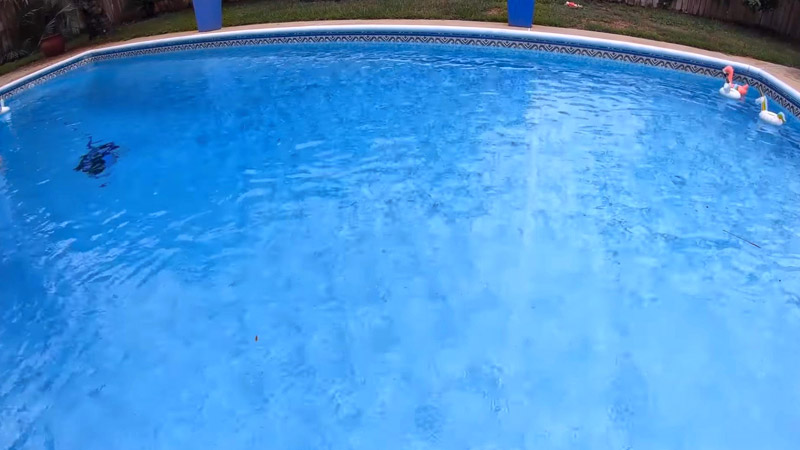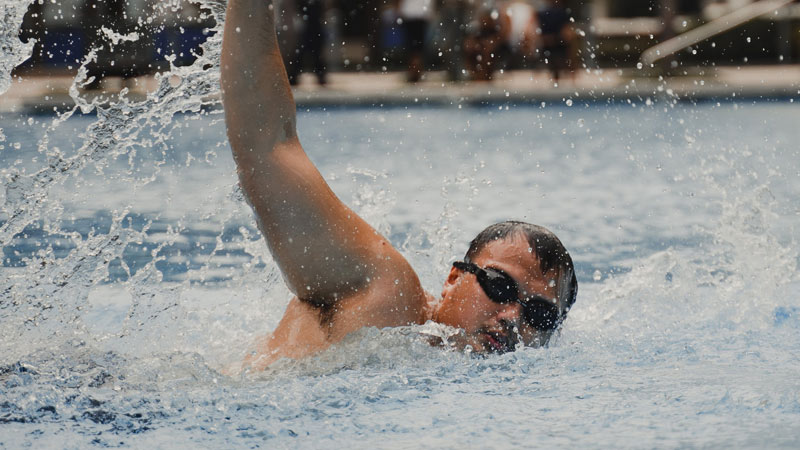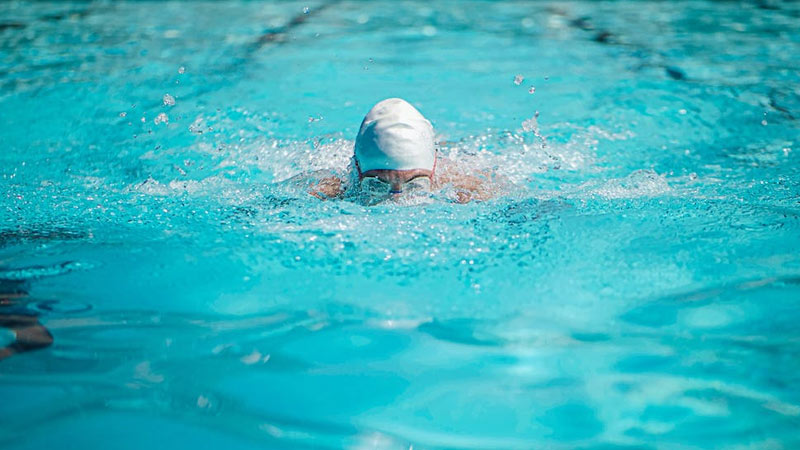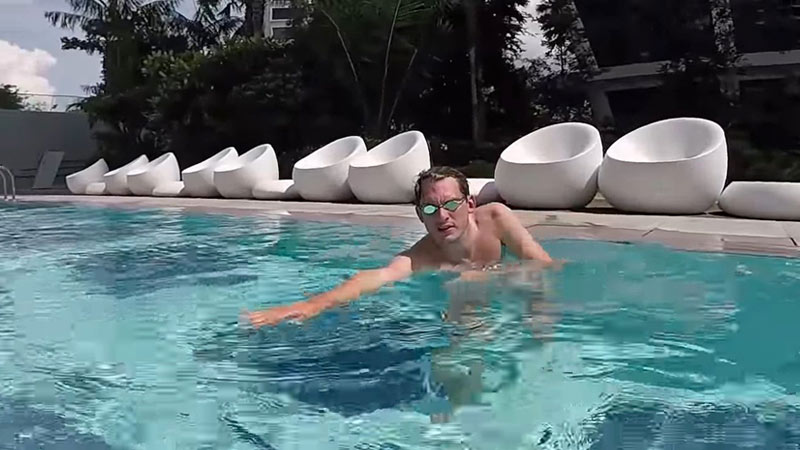Dipping into a refreshing pool is a quintessential summer pastime, but the allure of crystal-clear waters can sometimes mask potential dangers.
Understanding when a pool becomes unsafe to swim in is vital for ensuring a fun and secure aquatic experience.
From chemical imbalances that irritate the skin to inadequate filtration systems fostering waterborne threats, various factors contribute to a pool’s safety.
This exploration delves into the conditions that transform a serene pool into a potential hazard, emphasizing the importance of vigilance, regular maintenance, and structural integrity to guarantee a dip that’s not only enjoyable but also worry-free.
10 Harmful Signs When Is a Pool Unsafe to Swim In
Swimming is a refreshing way to beat the heat and stay active, but ensuring the safety of the pool you’re diving into is crucial.
A sparkling blue surface might seem inviting, but there are times when a pool can turn from a cool oasis to a potential hazard.
Here’s a look at when is a pool unsafe to swim in:
1. Cloudy or Discolored Water
Cloudy or discolored water can be a breeding ground for harmful bacteria and obscure potential dangers lurking beneath the surface.
It’s not just an aesthetic concern; it could indicate issues with the pool’s filtration and sanitation system. Before taking the plunge, make sure the water is crystal clear.
2. Strong Chlorine Smell
While a faint scent of chlorine indicates proper disinfection, an overwhelming smell can be a cause for concern.
It might mean there’s an excess of chlorine or other chemicals in the water, potentially causing skin and eye irritation. Balanced chemical levels are key for a safe and enjoyable swimming experience.
3. Lack of Proper Filtration
The filtration system is the pool’s first line of defense against impurities. If you notice the water seems stagnant or the filter looks clogged and neglected, it’s a sign that the pool may not be equipped to handle contaminants effectively.
4. Inadequate Pool Maintenance
A well-maintained pool is a safer pool. Debris, leaves, and algae not only affect water quality but also create slippery surfaces and harbor bacteria.
Regular cleaning, skimming, and maintaining the pool’s chemical balance are essential steps to prevent potential health risks.
5. Faulty Pool Equipment
Pumps, heaters, and other equipment need to be in working order for a safe swimming environment. Malfunctioning equipment not only affects water quality but can also lead to accidents or injuries. Regular inspections and prompt repairs are vital to keeping the pool in top condition.
6. Inadequate Chemical Levels
Chemical balance is a delicate dance. Insufficient or excessive levels of chlorine, pH, or other chemicals can compromise water quality.
Regular testing and adjustments are necessary to prevent the growth of harmful microorganisms and ensure a safe and enjoyable swim.
7. Lack of Safety Equipment
Accidents can happen, and having the right safety equipment on hand is crucial. Lifebuoys, first aid kits, and rescue equipment should be readily available. Check that these essentials are present and in good condition before diving into any pool.
8. Overcrowding
More isn’t always merrier, especially in a pool. Overcrowded swimming areas increase the risk of collisions, and injuries, and make it challenging for lifeguards to monitor everyone. Be mindful of posted capacity limits and enjoy the water responsibly.
9. Absence of Lifeguards
While experienced swimmers might feel confident, having trained lifeguards on duty is a significant safety measure.
They are equipped to handle emergencies and can provide immediate assistance if needed. Always choose swimming locations with lifeguard supervision, especially in public areas.
10. Water Temperature Issues
Extreme water temperatures can be more than just uncomfortable. Cold water can lead to hypothermia, especially in younger swimmers, while overly hot water can cause dehydration and overheating. Pay attention to the recommended temperature range for a safe and enjoyable swim.
Can You Swim in a Pool With Low Chlorine?

No, swimming in a pool with low chlorine levels is not advisable.
Here’s why swimming in a pool with low chlorine is not advisable:
Insufficient Disinfection
Chlorine is the unsung hero of pool maintenance, diligently working to eradicate bacteria, viruses, and other nasty microorganisms.
When chlorine levels are too low, it’s akin to sending our vigilant guardian on vacation, leaving the pool vulnerable to harmful pathogens.
This deficiency increases the likelihood of waterborne illnesses, turning what should be a refreshing swim into a potential health hazard.
Algae Growth
Low chlorine levels create a welcoming environment for algae to thrive. Algae not only transform the water into a murky, green mess but can also turn the pool surface into a slippery slope, posing a slipping hazard for unsuspecting swimmers.
Additionally, certain types of algae can harbor bacteria, compounding the issues associated with compromised water quality.
Increased Risk of Contamination
Adequate chlorine levels play a crucial role in breaking down contaminants introduced into the pool by swimmers—think sweat, urine, and skin oils.
When chlorine is lacking, these unwelcome guests linger, leading to poor water quality and creating a breeding ground for potential health hazards.
Risk of Recreational Water Illnesses (RWIs)
Low chlorine levels elevate the risk of Recreational Water Illnesses (RWIs), encompassing a spectrum of ailments from gastrointestinal discomfort to skin and respiratory infections.
A well-maintained chlorine concentration acts as a shield against these waterborne maladies, ensuring that the only thing swimmers take home is a sense of refreshment, not an illness.
Unstable pH Levels
Chlorine operates optimally within a specific pH range. If the pH levels drift beyond the recommended spectrum, the effectiveness of chlorine as a disinfectant diminishes.
Low chlorine levels often go hand in hand with pH imbalance, compounding the challenges in maintaining a safe and enjoyable swimming environment.
How to Know if a Pool Is Safe to Swim In?

Ensuring the safety of a pool involves a combination of regular maintenance, water testing, and vigilant observation.
Here’s a detailed guide on how to know when is it safe to swim in a pool:
Water Clarity
- Indicator: Clear, transparent water.
- Explanation: Murky or cloudy water can be a sign of inadequate filtration, chemical imbalance, or the presence of contaminants. Safe pools boast crystal-clear water, allowing you to see the pool floor and any potential hazards. Regularly clean skimmer baskets, remove debris, and run the pool filter to maintain water clarity.
Chemical Balance
- Indicator: Regular testing within recommended parameters for pH, chlorine, alkalinity, and other relevant chemicals.
- Explanation: Proper chemical balance is crucial for water disinfection and overall swimmer safety. Test the water regularly and adjust chemicals as needed to maintain optimal levels and prevent issues like skin irritation or the growth of harmful microorganisms. Consult with a pool professional for accurate and comprehensive water testing.
Chlorine Levels
- Indicator: Adequate and consistent chlorine levels.
- Explanation: Chlorine acts as a powerful disinfectant, keeping the water free from harmful bacteria and viruses. Use test kits to monitor chlorine levels and adjust accordingly to ensure a safe swimming environment. Regularly shock the pool to eliminate contaminants and maintain chlorine effectiveness.
Appropriate Filtration
- Indicator: Regular operation of the pool’s filtration system.
- Explanation: A functioning filtration system helps remove debris and contaminants from the water. Ensure that the pool filter is clean, and the system operates efficiently to maintain water clarity and quality. Backwash the filter as recommended and schedule professional maintenance checks.
Well-Maintained Pool Equipment
- Indicator: Proper functioning of pumps, skimmers, and other equipment.
- Explanation: Malfunctioning equipment can lead to poor water circulation and filtration, creating an environment conducive to algae growth and waterborne illnesses. Regularly inspect and maintain pool equipment to ensure they are in good working condition. Replace worn-out parts promptly.
Visible Safety Features
- Indicator: Clearly marked safety signs, lifeguard presence (if applicable), and well-maintained safety equipment.
- Explanation: A safe pool environment includes visible safety features such as depth markers, no-diving signs, and life-saving equipment. These elements contribute to the overall safety of the pool area. Conduct regular checks to ensure that safety features are visible and in good condition.
Proper Water Depth

- Indicator: Clearly marked depths and adherence to safety guidelines.
- Explanation: Ensure that the pool’s water depth is appropriate for different activities, and follow guidelines to prevent accidents or injuries. Diving should only be allowed in designated areas with sufficient depth. Enforce rules to prevent running and horseplay near the pool’s edge.
Regular Inspection of Pool Structure
- Indicator: Absence of visible cracks, leaks, or other structural issues.
- Explanation: A structurally sound pool is essential for safety. Regularly inspect the pool’s walls, floor, and surrounding areas for any signs of damage or wear. Address any issues promptly to prevent accidents and maintain overall pool integrity. Consult with a pool professional for comprehensive structural inspections.
How to Solve Common Pool Problems
Owning a pool comes with the promise of refreshing dips and sun-soaked relaxation, but it also entails dealing with occasional challenges. Fortunately, many common pool problems have straightforward solutions.
Let’s dive into how to tackle these issues and keep your pool pristine:
Cloudy Water
Solution: Test the water’s chemical balance, particularly the pH and chlorine levels. Adjust as needed to fall within the recommended ranges.
Consider using a pool clarifier to help filter out small particles. Run the pool filter for an adequate amount of time to ensure proper water circulation.
Algae Growth
Solution: Shock the pool with a high dose of chlorine to kill existing algae. Brush the pool walls and floor to loosen the algae, allowing the chlorine to work effectively.
Maintain the chlorine levels afterward and consider using algaecide to prevent future growth. Ensure proper water circulation and filtration.
Green Pool Water
Solution: This often indicates a severe algae problem. Shock the pool with a high concentration of chlorine and run the filter continuously until the water clears.
Brush the pool surfaces to assist in algae removal. Regularly monitor and maintain chlorine levels to prevent recurrence.
Low Chlorine Levels
Solution: Test the water and adjust chlorine levels as needed. Shock the pool if chlorine levels are critically low.
Ensure that the pool’s pH and alkalinity are within the recommended ranges, as these factors impact the effectiveness of chlorine. Regularly add chlorine to maintain the desired concentration.
pH Imbalance
Solution: Test the pH levels and adjust using pH increases or decreases accordingly. The ideal pH range is typically between 7.4 and 7.6. Imbalanced pH can affect the effectiveness of chlorine and lead to other water quality issues.
Clogged or Dirty Filters
Solution: Regularly clean or replace pool filters according to the manufacturer’s recommendations.
A clogged filter hampers water circulation and filtration efficiency. Clean skimmer baskets and remove debris from the pool regularly to prevent overworking the filtration system.
Leaking Pool
Solution: Identify the source of the leak. Common areas include pool fittings, pipes, and the pool shell. Consult with a professional if needed for major repairs.
For minor leaks, use pool patch kits or underwater sealant to address the issue temporarily until professional assistance is available.
High Total Dissolved Solids (TDS)
Solution: TDS levels rise over time due to various factors, including chemicals, debris, and water source impurities.
Partially draining and refilling the pool with fresh water helps lower TDS. Regularly monitor TDS levels and take preventive measures to maintain water quality.
FAQS
Can extreme weather conditions make a pool unsafe to swim in?
Yes, lightning, thunderstorms, and other severe weather conditions can pose a significant safety risk for swimmers.
How does poor air quality affect pool safety?
Poor air quality, often caused by inadequate ventilation in enclosed pool areas, can lead to respiratory issues for swimmers. Proper ventilation systems and regular air quality checks are essential for maintaining a safe swimming environment.
Are there specific health conditions that may make a pool unsafe for certain individuals?
Yes, individuals with certain health conditions, such as open wounds, infections, or weakened immune systems, may be more susceptible to waterborne illnesses.
Can a pool be unsafe even if it looks clean and clear?
Yes, appearances can be deceiving. A pool may look clean but still harbor harmful microorganisms if the chemical balance is off.
How does overcrowding affect pool safety?
Overcrowding can lead to increased contamination of the pool water, making it unsafe for swimming.
The pool’s capacity should be adhered to, and proper supervision should be in place, especially in public pools, to prevent accidents and ensure a safe swimming experience.
Last Words
The safety of a pool extends beyond its inviting appearance. Maintaining optimal chemical balance, filtration, and regular inspections are imperative to create a secure swimming environment.
From the unseen threats of microbial imbalances to the visible risks of structural issues, every aspect plays a role in determining a pool’s safety.
Weather conditions, health considerations, and the importance of adhering to capacity limits further contribute to the comprehensive approach needed.
By staying vigilant, addressing issues promptly, and incorporating preventative measures, pool owners and users alike can ensure that the shimmering waters not only beckon with allure but also guarantee a haven of safety and enjoyment.







